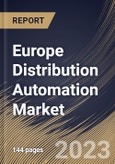Grid modernization is gaining momentum in many regions, untapped rural markets might have promising growth prospects. The potential for automated rural distribution is enormous. As people rely increasingly on electrical equipment, reliable power distribution is emerging as a crucial aspect. As a result, utility companies have a chance to target rural areas by offering distribution automation services. Consumers in rural areas are more knowledgeable and are better able to compare the number of supply interruptions between rural and urban distribution networks.
Having a steady supply of electricity promotes societal well-being, public safety, and health, as well as economic growth and progress. Additionally, it decreases the frequency and length of power outages, enhancing the distribution system's reliability. It also provides flexibility by allowing distributed energy sources to be used more frequently. Aside from that, DA devices also offer operational and maintenance advantages, including increased reliability by cutting the length of outages through employing an auto restoration system.
Governments throughout Europe are investing in advanced metering infrastructure as part of the growing efforts to modernize the electrical grid and reduce T&D losses. By 2024, the EU will have installed nearly 225 million smart meters for electricity and 51 million for gas. This entails a potential €47 billion investment. Nearly 77% of European users will have smart electricity meters by 2024. A gas one will be used by about 44%. Additionally, by 2020, the Member States of the European Commission have pledged to install over 200 million smart electricity meters and 45 million smart gas meters for a possible investment of €45 billion. Nearly 72% of European users will have a smart meter for electricity by 2020 and 40% for gas. Hence, all these factors will aid in expanding the regional market throughout the forecast period.
The Germany market dominated the Europe Distribution Automation Market by Country in 2022, and would continue to be a dominant market till 2030; thereby, achieving a market value of $2,230 million by 2030. The UK market is experiencing a CAGR of 10.4% during (2023-2030). Additionally, The France market would exhibit a CAGR of 12.2% during (2023-2030).
Based on Communication Technology, the market is segmented into Wired (Fiber Optic, Ethernet, and Powerline Carrier), and Wireless. Based on Utility, the market is segmented into Public, and Private. Based on Component, the market is segmented into Field Devices (Automated Feeder Switches/Reclosers, Remote Fault Indicators, Smart Relays, Automated Capacitors, Automated Voltage Regulators, Transformer Monitors, Remote Terminal Unit, Feeder Monitors, and Others), Software, and Services. Based on countries, the market is segmented into Germany, UK, France, Russia, Spain, Italy, and Rest of Europe.
The market research report covers the analysis of key stake holders of the market. Key companies profiled in the report include ABB Group, Schneider Electric SE, Siemens AG, Eaton Corporation PLC, General Electric Company, Itron, Inc., Toshiba Corporation, Xylem, Inc., G&W Electric, and S&C Electric Company
Scope of the Study
By Communication Technology
- Wired
- Fiber Optic
- Ethernet
- Powerline Carrier
- Wireless
By Utility
- Public
- Private
By Component
- Field Devices
- Automated Feeder Switches/Reclosers
- Remote Fault Indicators
- Smart Relays
- Automated Capacitors
- Automated Voltage Regulators
- Transformer Monitors
- Remote Terminal Unit
- Feeder Monitors
- Others
- Software
- Services
By Country
- Germany
- UK
- France
- Russia
- Spain
- Italy
- Rest of Europe
Key Market Players
List of Companies Profiled in the Report:
- ABB Group
- Schneider Electric SE
- Siemens AG
- Eaton Corporation PLC
- General Electric Company
- Itron, Inc.
- Toshiba Corporation
- Xylem, Inc.
- G&W Electric
- S&C Electric Company
Unique Offerings
- Exhaustive coverage
- The highest number of Market tables and figures
- Subscription-based model available
- Guaranteed best price
- Assured post sales research support with 10% customization free
Table of Contents
Companies Mentioned
- ABB Group
- Schneider Electric SE
- Siemens AG
- Eaton Corporation PLC
- General Electric Company
- Itron, Inc.
- Toshiba Corporation
- Xylem, Inc.
- G&W Electric
- S&C Electric Company








